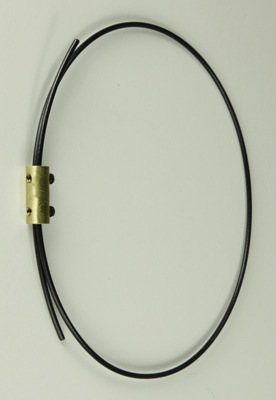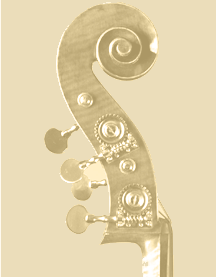Adjustable Bass Tailpiece Wire
 Why
do some luthiers/players prefer using an adjustable tailpiece wire?
It's all about the "partials" and how the bass vibrates acoustically
when the tailpiece wire is 'tuned'. Ok, it's easy to get
really bogged down with this sort of stuff and while a tailpiece
wire is not going to make as big a difference (tonally) to a bass as
a differnet bass bar or sound post will, all these odds and ends,
will combine to make up your bass' tonal personality and response.
Like a great spagetti sauce ("it's all in there!") Maybe
adding in or taking out something in the recipe might be just enough
to make that difference you are after. Why
do some luthiers/players prefer using an adjustable tailpiece wire?
It's all about the "partials" and how the bass vibrates acoustically
when the tailpiece wire is 'tuned'. Ok, it's easy to get
really bogged down with this sort of stuff and while a tailpiece
wire is not going to make as big a difference (tonally) to a bass as
a differnet bass bar or sound post will, all these odds and ends,
will combine to make up your bass' tonal personality and response.
Like a great spagetti sauce ("it's all in there!") Maybe
adding in or taking out something in the recipe might be just enough
to make that difference you are after.
In most cases still, good luthiers and players alike still lean
towards the old fashioned style 3/32 steel cable. On most of
our S.E. basses, we still love to use our sturdy reliable braided
steel (strong and will not twist) with a locked steel crimp which is
hid in the hollow cavity behind the lower part of the bass
tailpiece. This is quick, reliable and sturdy.
(Just in case you want one of these, you see and order one at our
bassa accessories page.)
On occasion, as every bass starts to 'reveal' its personality more
in the finale set up stages, we might find a different dead zone or
note on the bass that sticks out more or less (for whatever reason!)
One way, (in additition to sound post placement trials), is by
'tuning' the tailpiece wire length.: Changing the harmonic
partial outlay of the bass can really open up the sound and make it
more responsive and/or focused. All these descriptives are per
the individual bass player's needs/wants in his bass sound.
Sometimes small adjustments only make small or negligle differences,
but with the tailpiece lengths, getting the pitch (of the string
between tailpiece and bridge) exactly 2 octaves and a perfect forth
interval above that same open string will often maximize that bass'
potential. For example, on the G string, the higher pitch (between
bridge and tailpiece) should hopefully be a high C.
Order your adjustable "New Harmony" adjustable tailpiece wire:
$21.00
|


